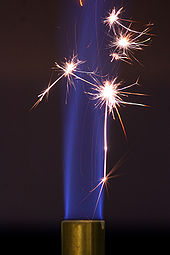
Back Aktiveringsenergie Afrikaans طاقة تنشيط Arabic Aktivləşmə enerjisi Azerbaijani Енергия на активация Bulgarian সক্রিয়ন শক্তি Bengali/Bangla སད་སློང་ནུས་པ། Tibetan Energija aktivacije BS Energia d'activació Catalan وزەی چالاککردن CKB Aktivační energie Czech

In the Arrhenius model of reaction rates, activation energy is the minimum amount of energy that must be available to reactants for a chemical reaction to occur.[1] The activation energy (Ea) of a reaction is measured in kilojoules per mole (kJ/mol) or kilocalories per mole (kcal/mol).[2] Activation energy can be thought of as the magnitude of the potential barrier (sometimes called the energy barrier) separating minima of the potential energy surface pertaining to the initial and final thermodynamic state. For a chemical reaction to proceed at a reasonable rate, the temperature of the system should be high enough such that there exists an appreciable number of molecules with translational energy equal to or greater than the activation energy. The term "activation energy" was introduced in 1889 by the Swedish scientist Svante Arrhenius.[3]
- ^ "Activation Energy". www.chem.fsu.edu. Archived from the original on 2016-12-07. Retrieved 2017-01-13.
- ^ Espenson, James (1995). Chemical Kinetics and Reaction Mechanisms. McGraw-Hill. ISBN 0070202605.
- ^ "Activation Energy and the Arrhenius Equation – Introductory Chemistry- 1st Canadian Edition". opentextbc.ca. Archived from the original on 2017-07-08. Retrieved 2018-04-05.